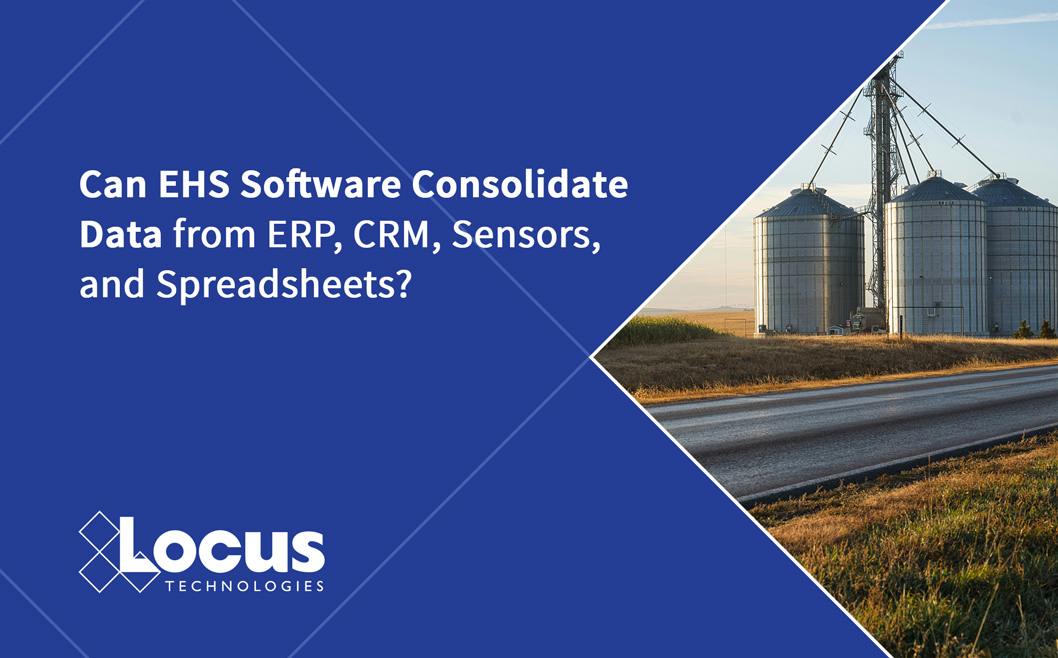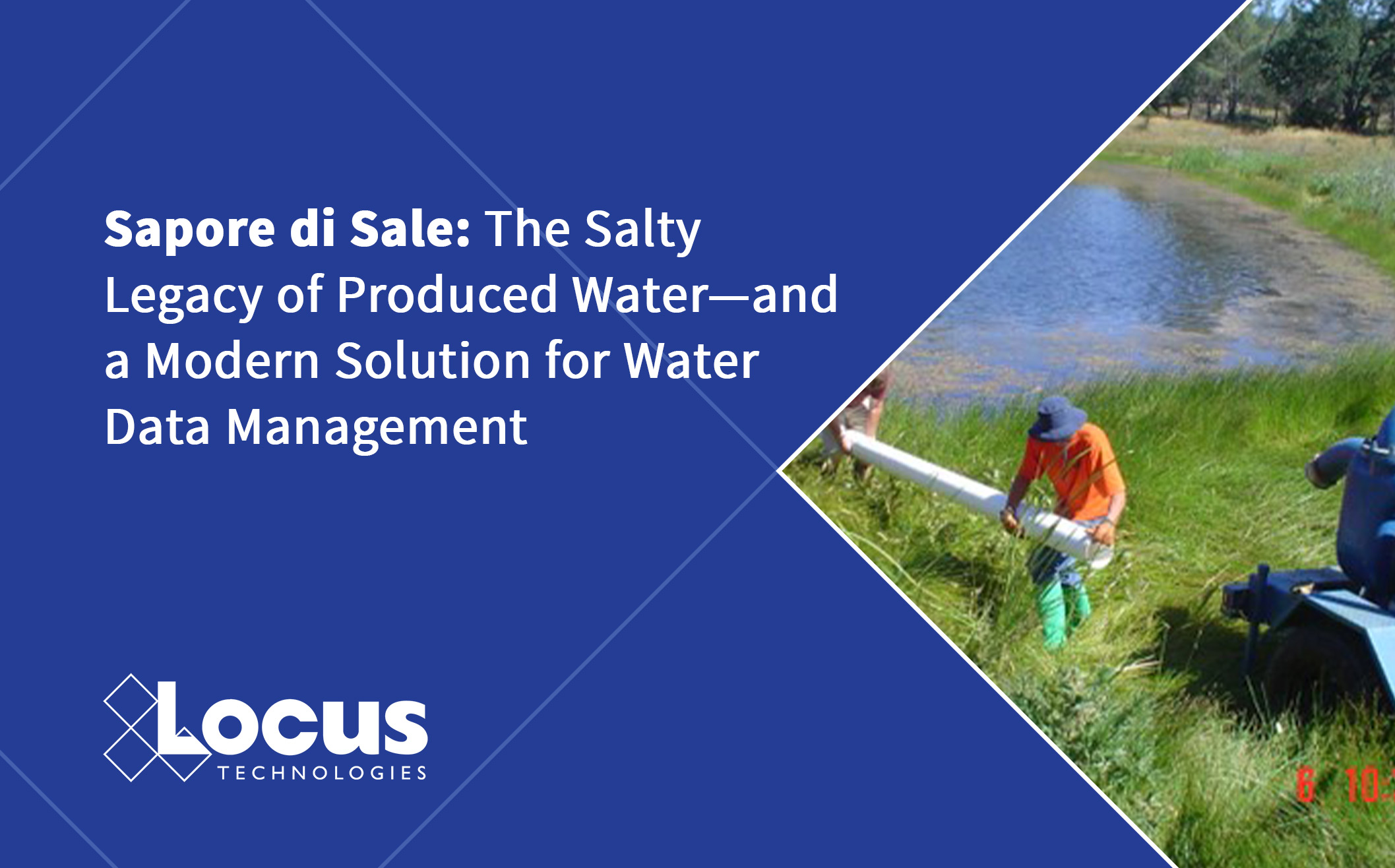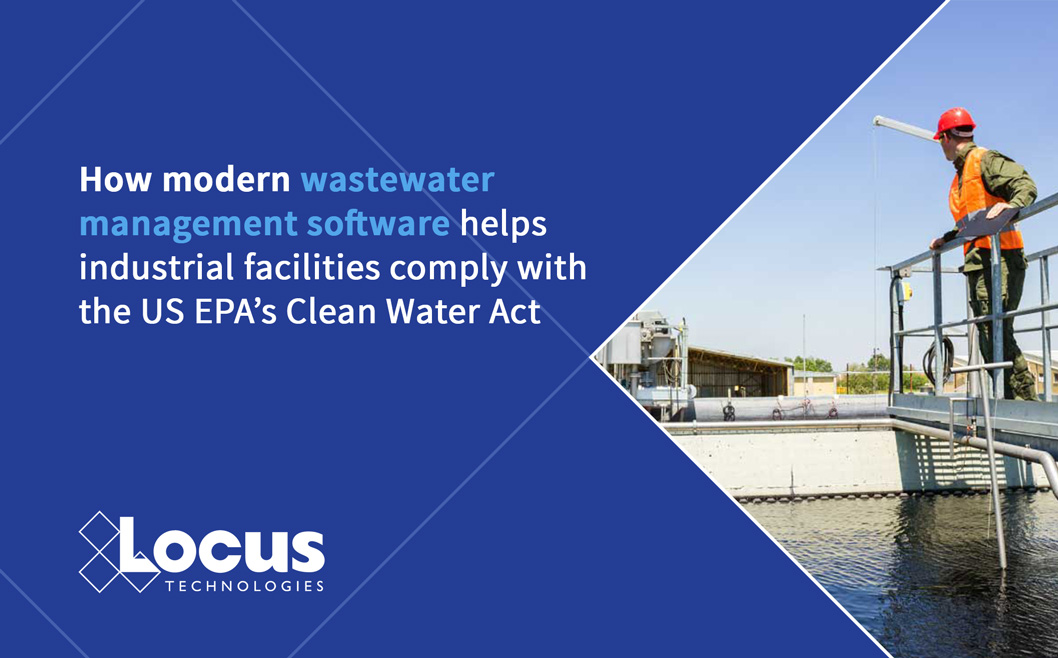
Why Data Consolidation Matters in EHS Software
In today’s environmental, health, and safety (EHS) landscape, data doesn’t live in one place. It’s spread across enterprise platforms like ERP, HR, and CRM software, spreadsheets, third-party consultants, LIMS databases, mobile devices, and smart field sensors. When this data remains siloed, the result is slow reporting, incomplete risk assessments, and missed opportunities for compliance and sustainability optimization.
Modern sustainability and EHS software must do more than just manage incidents, track permits, or report GHG emissions. It must act as a data hub, capable of integrating, harmonizing, and visualizing data from disparate sources in real time. This consolidated view enables better regulatory reporting (from NPDES to GHG disclosures), stronger operational decisions, and smarter ESG strategies. Entering data once and using it repeatedly is the name of the game in 2025.
Can Locus EHS Software Integrate and Consolidate Data from Multiple Sources?
Yes, absolutely. Locus EHS software is designed to consolidate and manage environmental data from a wide variety of third-party sources, including:
- Enterprise Resource Planning (ERP) platforms.
- Customer Relationship Management (CRM) software.
- SCADA, smart sensors, and IoT devices.
- Legacy spreadsheets and Access databases.
- Business intelligence tools and Geographical Information Systems (GIS).
- External consultants and verifiers.
- And any other siloed software with on-premise or single tenant installation.
By integrating all of these sources into a centralized, multitenant cloud platform, Locus enables organizations to monitor everything from Scope 1–3 emissions to waste manifests, refrigerant usage, and permit compliance—all through a real-time dashboard.
The Risks of Fragmented Environmental Data
Let’s consider a real-world scenario:
A global manufacturing firm is prioritizing its next round of capital investments. The committee relies on facilities management data to identify sites with the oldest or least reliable equipment. However, data about refrigerant leaks, which is a costly compliance and climate risk, is stored in a separate system the committee doesn’t access.
The result? They overlook critical equipment issues and miss a clear opportunity to reduce liability and emissions. If their systems had been integrated, they would have seen that a particular model of chiller commonly used across their facilities was responsible for repeated leaks and potential regulatory penalties.
What Data Sources Do EHS Professionals Rely On?
To understand the scope of data integration needs, consider the diverse systems that hold essential EHS data:
Environmental Data (E)
- LIMS (Laboratory Information Management Systems) and EDDs
- Business intelligence/mapping tools
- Legacy databases (Access, SQL)
- Consultant-managed reports
- Cloud-based environmental monitoring platforms
Health & Safety Data (H&S)
- Incident tracking software
- Spreadsheets and manual logs
- HR systems
- Risk management platforms
Social & Governance Data (S&G)
- ERP systems for supply chain and procurement
- HR and payroll databases
- Compliance tools
- ESG rating platforms
Greenhouse Gas (GHG) Emissions
- Smart sensors or meters in the field (IoT)
- Traditional SCADA systems
- Verifiers’ mobile applications
- Emissions calculation engines
- Utilities and fleet tracking software
Relevant data is spread all over the place in silos that may or may not “speak” to one another. In fact, Gartner states that “by 2025, more than 50% of enterprise-critical data will be created and processed outside the data center or cloud.”[i]
How Does EHS Software Like Locus Consolidate This Data?
Data consolidation refers to collecting, connecting, and standardizing data from multiple sources into a single platform where it can be viewed, analyzed, and acted upon in real time. This process relies on secure integration protocols, and today, that often means using RESTful APIs.
RESTful APIs vs. Traditional Integration Methods
RESTful APIs are the preferred method for connecting modern software systems. Compared to older technologies, these APIs are more flexible and easier to implement, highly scalable, and very low maintenance. By using REST APIs, Locus can pull emissions data from IoT sensors, retrieve procurement info from ERP systems, and connect to other third-party tools.
According to Gartner’s Hype Cycle for APIs, 2024, 82% of enterprises already use APIs internally, and 71% use APIs provided by SaaS vendors or generative AI companies1. These figures reinforce the importance of API-driven integrations for digital transformation in EHS management.
Why APIs are Critical for AI-Enabled EHS
Many organizations are exploring AI to streamline EHS functions—such as predicting emissions trends or flagging high-risk facilities. But AI models are only as good as the data they’re trained on.
To use AI effectively:
- Data must be complete and validated.
- Systems must be interoperable.
- Insights must be timely and actionable.
API integrations allow Locus to deliver clean, connected data that supports both human decision-making and automated insights from AI tools.
The Benefits of a Consolidated, Connected EHS Data Platform
When all relevant data is connected and consolidated into one dashboard, the benefits are immediate and strategic. Here are some examples.
- Accurate Regulatory Reporting: Quickly generate audit-ready reports for Title V, TRI, NPDES, GHG disclosures, and more—without chasing down spreadsheets or consultants.
- Proactive Environmental Management: Identify cross-site trends, recurring issues, and root causes faster through unified dashboards.
- Reduce Compliance Risk: Get real-time alerts when emissions or waste metrics exceed thresholds, enabling early intervention.
- Streamline Operations: Automate data collection, reduce manual entry, and free up staff to focus on higher-value tasks.
- Better Capital Planning: Use holistic data such as leak rates, equipment age, and facility emissions to inform investment decisions.
- Readiness for ESG and AI: Ensure your organization is prepared for evolving ESG frameworks and future AI-driven analysis tools. Connecting and consolidating your data makes you more agile.
So, can EHS software consolidate data across ERP, CRM, sensors, spreadsheets, and scope 1-3 sources for display in a real-time dashboard?
Yes, and it must.
Disconnected systems lead to blind spots, delayed reports, and missed risks. With Locus EHS software’s cloud-native design and robust API integrations, environmental professionals can move from fragmented data to real-time visibility, strategic control, and compliance confidence.
For professionals managing complex environmental data, the ability to unify, visualize, and act on information across platforms isn’t a luxury—it’s now the baseline for effective EHS and ESG performance.

Frequently Asked Questions about EHS Data, Integration and Consolidation
What is a data silo?
Data silos occur when multiple, disconnected systems store data. These silos could be locally stored files, department-specific software products, external consultants’ repositories, etc.
Why are data silos problematic for EHS initiatives?
Data silos impede the efficient analysis of comprehensive data. When relevant information is distributed across multiple silos, a company could be at risk. For example, data analysis and the subsequent output (reports, exports, etc.) will be incomplete and skewed. To neutralize those risks, stakeholders face the monumental task of identifying the stray sources, collecting their respective data, and integrating the data with the rest.
Where is EHS-related data usually stored?
The data that matters to EHS and sustainability initiatives may be distributed across multiple software products, servers, locations, and desktops. Some examples include spreadsheets and obsolete databases, BI and GIS tools, LIMS, HR and payroll platforms, incident tracking software, ERP systems, smart sensors and utilities, and facilities management software.
What is consolidated data?
Data consolidation refers to collecting, connecting, and standardizing data from multiple sources into a single platform where it can be viewed, analyzed, and acted upon in real time.
What is an API?
Application Programming Interfaces (APIs) enable unrelated software applications to communicate and exchange information. Multiple types of APIs exist.
How do APIs facilitate the use of AI for EHS programs?
APIs are key to unifying disparate data sources, which goes together with leveraging the power of AI. The reliable use of AI for EHS professionals requires access to validated data – and API integrations can extend access to a broader pool of relevant information.
Locus is the only self-funded water, air, soil, biological, energy, and waste EHS software company that is still owned and managed by its founder. The brightest minds in environmental science, embodied carbon, CO2 emissions, refrigerants, and PFAS hang their hats at Locus, and they’ve helped us to become a market leader in EHS software. Every client-facing employee at Locus has an advanced degree in science or professional EHS experience, and they incubate new ideas every day – such as how machine learning, AI, blockchain, and the Internet of Things will up the ante for EHS software, ESG, and sustainability.



